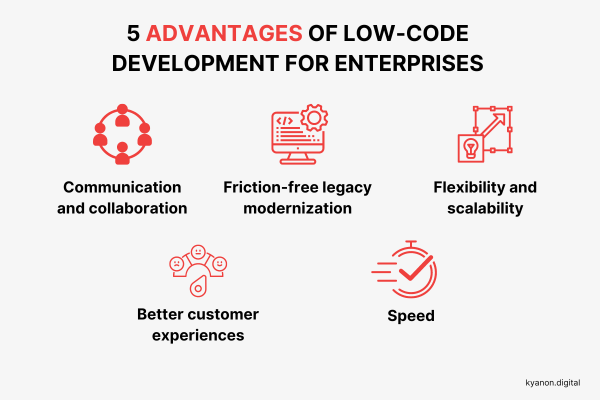New Facts For Selecting application development with Low-code platforms
New Facts For Selecting application development with Low-code platforms
Blog Article
Benefits Of Low-Code Application Development In Terms Of Integration Capabilities
Low-code app development has many advantages, particularly in terms of integration. This is important in creating apps that seamlessly connect with platforms and services. Here are some of the key benefits: Prebuilt Connectors & APIs
A Variety of Connectors : Low-code platforms typically come with a vast library of prebuilt connectors to the most popular enterprise systems (e.g. ERP CRM, databases, and cloud services). This simplifies integration with the systems.
API Integration: Many low code platforms come with integrated API capabilities out of the box that let developers connect easily with external data sources and services.
Simple to use:
Integration via Drag and Drop: Integration tasks are often done using drag and drop interfaces. Developers and non-developers are able to set up complex systems that integrate without having to write code.
Visual Workflow Builders : Software for creating workflows and data flows that are visually represented help to learn and configure integrations in a much more simple way.
Standardized Integration Methods:
SOAP and RESTful Service The support for web services standardization such as REST and SOAP allows easy integration with many other systems.
OData and other Standards Support for standards like OData facilitates the transfer and manipulation of data across different platforms and applications.
Real-Time Data Synchronization:
Low-code platforms allow for real-time integration between systems as well as applications. This allows information to be consistent and updated throughout the company.
Event-Driven Architect: A few platforms have events-driven structures, allowing applications to react instantly to any event. This is crucial for interactive and dynamic applications.
Legacy System Integration:
Bridging Old Systems and New Systems Low-code platforms often provide the tools needed to integrate with older systems. This allows organizations to upgrade their IT Infrastructure without having to overhaul the current systems.
Data Migration Tools Data Migration Tools aid in the transfer of data from outdated systems to new software built using low-code platforms.
Third-Party Services Integration:
Cloud Services: Seamless Integration with Cloud Services such as AWS Azure Google Cloud and Google Cloud makes it easy to deploy applications.
Business Applications Integration : Low-code platform allows integration with various applications for business, like Salesforce.com, SAP, Microsoft Dynamics and more, to enable a seamless workflow across different business processes.
Simplified data management:
Unified data models: Certain platforms provide low-code support for unified models of data to facilitate data management across systems.
Data connectors: Data connectors that are preconfigured to allow easy access and modification on data from various sources.
Security and Compliance
Secure Integrations: Low code platforms ensure that integrations conform to security protocols as well as standard security standards, securing data in transit as well as at rest.
The platforms come with features that ensure that integrations are compatible with regulatory requirements.
Extensibility:
Custom Code and Scripts: Low-code platforms tend to accommodate more complex integrations through the use of custom scripts and codes. This allows for flexibility without sacrificing user-friendliness.
Plug-in Ecosystems. A network of plug-ins and extensions can allow you to further enhance the capabilities of integration, while adding new features whenever you need to.
In general low-code development platforms provide robust integration capabilities that make them a great device for developing functional and interconnected applications. They make it easier for linking disparate systems. They increase the flow of information, and allow businesses to leverage existing technologies while incorporating new ones, thus ensuring a cohesive and integrated IT environment. View the best Low-code Platform for application development for site recommendations including no code platforms, rapid applications, push notifications android, app development platform, mobile development platforms, rad application development, develop web application, push notifications android, cross platform app dev, low code development platforms and more.
Cost-Effectiveness Is Just One Of The Many Advantages Of Developing Applications That Use Low-Code.
Low-code applications offer a variety of advantages when it comes to cost-effectiveness. Companies looking to optimize budgets can benefit from this method while still delivering high-quality applications. Here are a few of the major advantages:
Reduced Coding: Low-code systems cut down on the amount of hand-coding that is required, which in turn saves developers time and energy when building applications. Also, it means less labor cost.
A smaller number of developer resources: As low-code development is more efficient and simpler, less specialized developers are needed. This will significantly cut down on the cost of hiring and staffing.
Time to market faster:
Accelerated Cycle of Development: Low-code platform visual tools and components allow for rapid development of applications, which allows businesses to launch products faster. This could result in faster revenue generation and improved position in the marketplace.
Rapid prototyping: By developing rapid prototypes and testing them quickly companies can cut down on the time they spend in the development phase and allow for quicker iterations on the basis of user feedback.
Lower Maintenance Costs
Due to their modularity as well as common components, applications developed on low-code platforms are easier to maintain. This will reduce the cost of maintenance and ongoing support.
Automated Updates: A lot of low-code platforms handle patches and updates in a way that is automatic, ensuring applications remain secure and up-to-date, without the need for lengthy manual intervention.
Efficient Resource Utilization:
Low-code platform contributions allow businesses as well as others who are not developers to take part in the process of creating. This democratization enables enterprises to profit from the expertise of a broad spectrum of employees.
Improved Utilization of IT Resources: IT departments are able to focus on more strategic endeavors instead of being slammed by routine tasks of development which can increase overall productivity and efficiency.
Price models that are scaleable:
Subscription-based Prices: Many lowcode platforms have flexible, subscription-based pricing plans that rise as users use them. This allows businesses the ability to adapt their spending according to their needs and growth without incurring large upfront costs.
Pay-As-You-Go: A few platforms provide pay-as-you-go options. This allows businesses to only pay for resources that they actually need. This is particularly beneficial for small and new businesses with limited budgets.
Reduction of Third-Party Costs for Software:
Built-in Functionalities : Low-code software typically comes with built-in functions and integrations, which eliminates the requirement for additional third-party software, tools, and licenses.
Pre-Built Integrations: The existence of pre-built integrations that integrate with the most popular systems and services reduces the requirement for custom development, thereby saving time and money.
Better ROI:
A faster return on investment (ROI): By making use of the rapid development process, lower costs and a shorter time to the market, businesses can get a faster ROI for their applications.
Enhanced agility: Businesses can adapt quickly to changes on the market or customer demands, which allows businesses to stay relevant and take advantage of new opportunities.
Training costs are cheaper:
User-Friendly Interfaces: Low code platforms provide intuitive and simple-to-use interfaces, which decreases the learning curve.
Accessible Resources A lot of low-code platforms provide comprehensive training materials, tutorials and community support, further lessening the need for formal training and associated cost.
Collaboration is simplified:
Enhanced collaboration Tools Collaboration tools are integrated into the workflow. This enables improved collaboration between team members, as well as a reduction in project overhead.
Unified Development Environment. A single integrated software development environment could streamline processes and reduce the complexity and cost of managing multiple platforms and tools.
Overall, the cost effectiveness of software development using low-code is due to its ability to reduce the cost of maintenance and development and increase time to market and optimize the use of resources and provide flexible price models. Low-code provides significant financial benefits to businesses. Check out the top rated Legacy application modernization with Low-code info for blog examples including app development platform, cross platform app development, microsoft azure sql, cross platform mobile app development, cross platform app development, develop mobile application, azure sql, develop cross platform mobile app, develop web app, azure sql and more.
Advantages Of Low-Code Application Development In Terms Of Limitations And Customization
Low-code app development is a balanced solution that offers significant benefits in terms of overcoming limitations while also permitting customization. Here are the benefits:
Resolving Complexity:
Simplified Development: Low-code platforms reduce the complexity of development by providing templates and components pre-built for you, enabling quicker development and deployment for complex applications.
Numerous platforms offer wizards and guided workflows to help developers navigate difficult processes. These tools reduce the chance of making mistakes, and help ensure uniformity.
Scalability Solutions
Built-In Scalability: Low-code platforms typically include features that allow scalable architecture, allowing applications to handle increased loads without significant redevelopment.
Performance Monitoring: Using instruments for monitoring performance optimization, tuning and monitoring help applications scale efficiently.
Security and Compliance
Integrated security features: Low-code platforms have security measures like encryption and access control based on role and automated compliance checks that address security issues.
Platforms regularly update their compliance and security measures to ensure that applications are protected against new threats.
Customization Features:
Extensibility:
Low-code platforms can often be able to integrate custom code, such as JavaScript or Python which allows developers to expand their capabilities beyond what is normal.
Developers can design custom plugins and modules which add features that are that are tailored to the specific requirements of a business.
APIs and Integration:
API Support: A full API support is available to enable seamless integration and connectivity with external systems.
Third-Party services: Low code platforms have connectors built for popular third party services. This makes it simpler to build and integrate applications.
Flexible UX/UI Designs:
Customizable Interfaces Developers are able to design and customize user interfaces based on specific branding and usability requirements and create a personalized user experience.
Responsive design: The capability to adapt applications to different screens and devices is included.
Business Logic Customization
Visual Workflow builders: These tools allow developers create complex processes with little or no coding. They can design workflows and business logic in a visual manner.
Platforms can provide conditional logic to adapt to specific business rules or scenarios.
Data Management:
Custom Data Models Developers can create custom data models that are customized to meet specific business requirements. This ensures data handling is customized to every application.
Advanced Data Processor: The integration of advanced data-processing tools and capabilities allows for the modification of the way data is analysed and used in the application.
Balancing Limitations with Customization:
Frameworks, Standards and Standards:
Low-code Platforms Support Industry Best Practices and Standards: Low-code platforms encourage adherence to industry-standard best practices and standards. This makes it easier to maintain high-quality, secure, and adaptable applications.
Governance Frameworks: Built-in governance frameworks ensure that any modifications do not interfere with the integrity, security, or compliance of the application.
Iterative Development:
Rapid Prototyping: The ability to quickly prototype and test customizations ensures that developers can refine their applications based on feedback from users and refine the application to better meet user needs.
Continuous Improvement: Platforms with low-code enable continuous improvement, allowing customization and enhancement as the business requirements evolve.
User Empowerment:
Low-code platforms empower citizen developers: By allowing non-developers, with intuitive interfaces, to personalize applications, they increase the number of contributors who can improve and customize applications.
Training and Support Resources: Many platforms provide extensive training and support materials that allow users to modify applications without compromising functionality or stability.
Overall, low-code application development offers a robust framework for addressing limitations while providing ample opportunities for customization. This balance ensures businesses can create and maintain apps that are customized and functional to meet their particular requirements while maintaining high standards of quality, safety and the ability to scale.